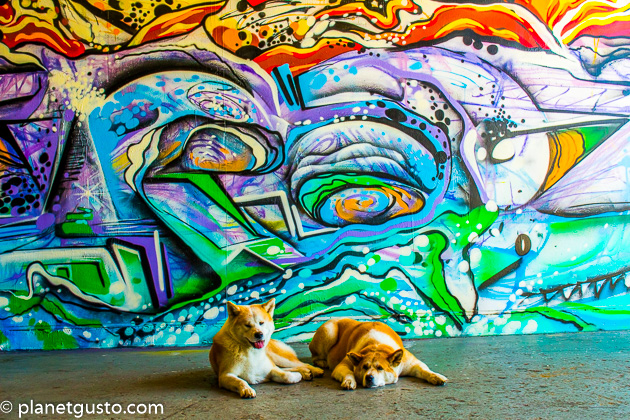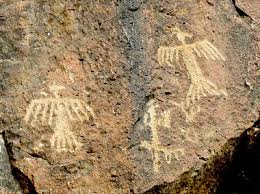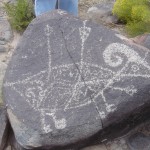I discovered Irot one day walking down Webster Street in Oakland, when I happened upon his stunning “Indian Chief Wearing War Bonnet,” striking against its bold red brick wall. I was mesmerized. And I immediately began following Irot on Instagram, which is how I discovered that he had a show going on at the Oakland Terminal Gallery.

Oakland Terminal is a little far afield for the car-less. Yet on closing day of Irot’s show, “April Ain’t for No Fool!,” I was intent on not missing it. So I ventured out on foot from downtown Oakland and hiked the mile and a half down Grand Avenue to the industrial McClymonds neighborhood. Cars whizzed by me down Grand, anxious to catch the Bay Bridge into San Francisco.


As I got further away from downtown, the streets began to feel more desolate with overgrown weeds and deserted buildings. Yet I was energized by the rawness and the sightings of random murals and pervasive intricate graffiti.



As I turned onto Union Street where Oakland Terminal is situated, I was greeted by the colorful fence-lined graffiti that vitalized the otherwise monochromatically grey street. The convergence of graffiti with industrial angles and sculptural barbed wire gave this ‘hood a mixed media vibe. Few humans were about, and I almost expected to see a tumbleweed roll past.




When I reached the corner of 26th Street, it was apparent that I had arrived at Oakland Terminal.

There was Irot outside the gallery, aerosol paint cans in-hand, doing a live demonstration. Watching how quickly his canvas transformed was captivating.

I reluctantly pulled myself away from Irot’s demo and headed into the gallery to look around.

At the gallery entrance I was instantly greeted by Irot’s quirky sense of humor where a kitschy polar bear sat watching over Irot’s striking wall-sized abstract mural.


This foreshadowed an eclectic exhibit full of contrasts, especially in the context of Oakland Terminal’s stark architectural backdrop.
The exhibit quickly segued to Irot’s Native American, New Mexico roots. A Mescalero Apache, Irot grew up on a reservation in southern New Mexico inspired by, arguably, his first street art – Mogollon petroglyphs.

The ancient Mogollon region is situated just south of New Mexico’s Santa Fe/Anasazi region, and extends into the Sonora and Chihuahua regions of Mexico. Home to the Mogollon Mountain range, this region of New Mexico also contains the Gila Cliff Dwellings. The Mogollon people can be traced as early as AD 300.
In addition to these powerful influences, Irot was also swept into the local graffiti scene as a teenager, and later attained a degree in fine arts. The confluence of these experiences was evident as I moved further into the gallery. If I had walked into the gallery perceiving Irot as simply a terrific street artist, this was quickly contradicted by his small and beautiful illustrations of Indian Chiefs.
But just as I was lulled into his more classic style drawings, I found myself suddenly confronted by Irot’s comic book style that just as quickly transitioned into Irot’s signature birds that meld a pop art sensibility with his Native American roots.



This is why I find Irot’s work so compelling. He is complex, blending contemporary grittiness and pop with spirituality and whimsy – refusing to be pigeon-holed.

A nice touch to the show was a video loop of Irot working on his large mural, providing insight into how he works.

After I had taken in the whole show, I headed back outside and chatted with Irot. He was in the midst of explaining that he views his art as always evolving. As a street artist it goes with the territory that someone might paint over his work. But then he also has the opportunity to go back and fix it – ultimately changing the initial work into something completely different… perhaps even an unintended collaboration. Indeed, this was part of his demo that day as he tag-teamed his outdoor canvas to illustrate how the art can change.




I found it thought-provoking to perceive this “new” art form in this way – almost flipping pre-conceived notions of respecting art. And I imagine when you’re a street artist you need to be a little philosophical about your work, as it comes with the territory that you have no real control over your art that inherently becomes part of the public landscape. Irot’s stunning “Indian Chief,” located on Webster Street in downtown Oakland, has been entangled with the changing urban landscape as construction of a new parking lot unfolds. Happily, the lot will be a flat one and leave the “Indian Chief” in tact and openly on display.

I suppose the difference in this digital age is that there is now a trend for marketing street art that can preserve it in another medium, such as prints and other merchandise like T-Shirts. Harking back somewhat to Warhol and art being reproduceable.
Irot’s philosophy certainly made me view the street art medium differently, and I went back inside to take in Irot’s show with a new perspective. As I was taking another loop around the gallery, I stopped to talk with Alex one of the gallery’s directors, who is clearly very passionate about her work with local artists, as well as Oakland Terminal’s relationship with the community and schools.


I was particularly fascinated when Alex explained that Oakland Terminal’s approach to their shows is not to curate but to let the artist direct placement, using the gallery as their canvas to truly reflect the artist’s view. This revelation again transformed my perspective on Irot’s show.
Oakland Terminal has a raw, down-to-earth feel in its industrial warehouse setting. Initially the warehouse space was used to feature the gallery owners’ love of vintage cars, of which a few were still on display outside. But this venture turned out not to be sustainable.

Luckily for Oakland, the gallery owners’ affinity for collecting art and strong relationships with the art community soon transitioned the warehouse into the Oakland Terminal Gallery, which is approaching its one-year anniversary. As downtown Oakland begins to feel more Main Street, Oakland Terminal is a breath of fresh air as something authentically edgy and urban.
Irot says his next venture sends him back to his roots in New Mexico – and you can follow on Instagram. While the “April Ain’t for No Fool!” show is now over, Irot’s work is all over Oakland – and San Francisco.
Oakland Terminal Gallery’s next show starts on May 1, and they have exhibitions booked already for the next year.
And you’ll be happy to know that the polar bear has been released back into the wild.
Update: Mondo the Polar Bear is Missing!
Irot – follow him on Instagram at @Irot_one.
Oakland Terminal – To keep up on the Gallery’s activities, check out their Facebook page and follow them on Instagram. The Gallery is open Monday – Saturday.







